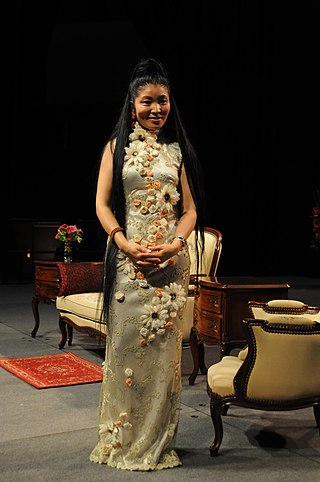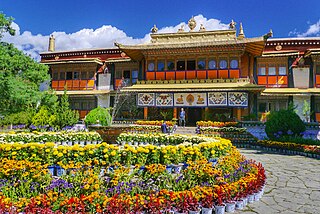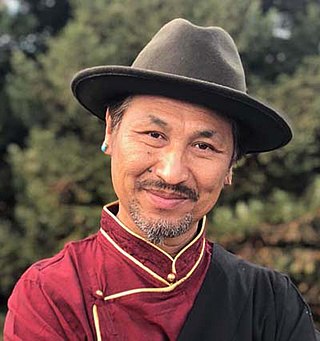Related Research Articles

Yungchen Lhamo is a Tibetan singer-songwriter living in the United States. She won the ARIA Award for Best World Music Album in 1995 and was then signed by Peter Gabriel's Real World record label.
Jampa Tsering was a Chinese singer and dancer. He is of Tibetan ethnicity.

The music of Tibet reflects the cultural heritage of the trans-Himalayan region centered in Tibet, but also known wherever ethnic Tibetan groups are found in Nepal, Bhutan, India and further abroad. The religious music of Tibet reflects the profound influence of Tibetan Buddhism on the culture.

Norbulingka is a palace and surrounding park in Lhasa, China built from 1755. It served as the traditional summer residence of the successive Dalai Lamas from the 1780s up until the 14th Dalai Lama's exile in 1959. Part of the "Historic Ensemble of the Potala Palace", Norbulingka is recognized as a UNESCO World Heritage Site, and was added as an extension of this Historic Ensemble in 2001. It was built by the 7th Dalai Lama and served both as administrative centre and religious centre. It is a unique representation of Tibetan palace architecture.
The National Heritage Fellowship is a lifetime honor presented to master folk and traditional artists by the National Endowment for the Arts. Similar to Japan's Living National Treasure award, the Fellowship is the United States government's highest honor in the folk and traditional arts. It is a one-time only award and fellows must be living citizens or permanent residents of the United States. Each year, fellowships are presented to between nine and fifteen artists or groups at a ceremony in Washington, D.C.
Khams Tibetan is the Tibetic language used by the majority of the people in Kham. Khams is one of the three branches of the traditional classification of Tibetic languages. In terms of mutual intelligibility, Khams could communicate at a basic level with the Ü-Tsang branch.
Tibetan Freedom Concert is the name given to a series of socio-political music festivals held in North America, Europe and Asia from 1996 onwards to support the cause of Tibetan independence. The concerts were originally organized by the Beastie Boys and the Milarepa Fund. The idea for a Live Aid-style concert for Tibet was conceived by members of the group during the 1994 Lollapalooza Tour.

The Sho Dun Festival, commonly known as the Shoton or Yogurt Festival or Banquet since "Sho" means Yogurt and "Dun" means Banquet, is an annual festival held at Norbulingka or "Jewel Park" palace in Lhasa, Tibet Autonomous Region.

The Tibetan Institute of Performing Arts (TIPA) was founded by Tenzin Gyatso, the 14th Dalai Lama on reaching McLeod Ganj, Himachal Pradesh, India in exile from Tibet in August 1959. It was then called Tibetan Music, Dance and Drama Society, which was one of the first institutes set up by the Dalai Lama, and was established to preserve Tibetan artistic heritage, especially opera, dance, and music.

Namgyal Lhamo is an internationally acclaimed Tibetan Opera, classical singer and actor. She is based in Utrecht, The Netherlands.

Lhamo, or Ache Lhamo, is a classical secular theatre of Tibet with music and dance that has been performed for centuries, whose nearest western equivalent is opera. Performances have a narrative and simple dialogue interspersed with comedy and satire; characters wear colorful masks. The core stories of these theatrical plays are drawn mostly from ancient Indian Buddhist folk tales, lives of important people and historical events from Tibetan civilization. However the ceremonial, dance and ritual spectacles strongly reflects the Tibetan Royal Dynastic period.

Tsering Dorjee Bawa is a Tibetan actor, producer, musician and dancer of Tibetan descent. He acted in the Oscar nominated film ‘Himalaya' in 1999 and has created the original soundtrack with Michael Becker for 2009 Emmy Award-winning documentary ‘The Woman of Tibet - A Quiet Revolution’. He was nominated twice for outstanding featured performance in play, male for his off-Broadway show, 'The Oldest Boy'.

The Samding Dorje Phagmo is the highest female incarnation in Tibet and the third highest-ranking person in the hierarchy after the Dalai Lama and the Panchen Lama. She was listed among the highest-ranking reincarnations at the time of the 5th Dalai Lama, recognized by the Tibetan government and acknowledged by the emperors of Qing China. In her first incarnation, as Chökyi Drönma, she was the student and consort of the famous polymath Thang Tong Gyalpo, who first identified her as an emanation of Vajravārāhī, and the consort of Bodong Panchen. The seat of the Samding Dorje Phagmo is at Samding Monastery, in Tibet.

Losang Samten is a Tibetan-American scholar, sand mandala artist, former Buddhist monk, and Spiritual Director of the Chenrezig Tibetan Buddhist Center of Philadelphia. He is one of only an estimated 30 people worldwide who are qualified to teach the traditional art of Tibetan sandpainting. He has written two books and helped to create the first Tibetan sand mandala ever shown publicly in the West in 1988. In 2002, he was made a National Heritage Fellow by the National Endowment of the Arts. In 2004, he was granted a Pew Fellowship in Folk and Traditional Arts.
Garu Nunnery is a historical hermitage, belonging to Sera Monastery. It is located north of Lhasa, Lhasa Prefecture, in the Tibet region of China. The nunnery has an ancient history traced to Padmasambhava, the Indian Buddhist preceptor, who visited this location. He not only named the place as "Garu" but also ordained that it shall be a "Nunnery" not a monastery of monks on the basis of prophetic visions he had during his visit to the place. In the late 1980s and early 1990s, some nuns from the monasteries have made publicized demonstrations for Tibetan independence. Many of the protesting nuns were arrested, incarcerated, brutally handled and released only after protracted detention.

Drapchi is a 2013 Tibetan-language Film directed by Arvind Iyer and stars acclaimed Tibetan singer Namgyal Lhamo in the lead role as Yiga Gyalnang. The film is a musical drama set against the backdrop of Tibet and Nepal and based on a true story. Drapchi has screened at the Manneim-Heidelberg, Cairo International, Warsaw International, Kerala International and Rome Independent Film Festival.

Tenzing Sonam is a Tibetan film director, writer and essayist based in Dharamshala. He works through his production company, White Crane Films, which he runs with his partner, Ritu Sarin.

Polhané Sönam Topgyé was one of the most important political personalities of Tibet in the first half of the 18th century. Between 1728 and 1747 he was effectively the ruling prince of Tibet and carried royal titles during the period of Qing rule of Tibet. He is known as an excellent administrator, a fearsome warrior and a grand strategist. After the troubled years under the reign of Lhazang Khan, the bloody invasion of Tsering Dhondup and the civil war, his government ushered in a relatively long period of stability and internal and external peace for Tibet.

Sonam Dolma Brauen is a Tibetan-Swiss contemporary painter and sculptor.
Tashi Tsering, born in 1929 in Guchok, Namling County, Shigatse prefecture, and died on December 5, 2014 (aged 84–85) in Lhasa, is a Tibetan of peasant origin, author of the autobiography, My fight for a modern Tibet, Life story of Tashi Tsering, where he describes the life he led successively in pre-communist Tibet, in exile in India and the United States, and finally back in China during the Cultural Revolution, between Tibet and Eastern China in the decades that followed.
References
- 1 2 3 4 5 6 7 8 9 10 "Tsering Wangmo Satho". www.arts.gov. Retrieved August 30, 2023.
- 1 2 3 4 5 6 7 Kharrazi, Lily (July 22, 2022). "Celebrating California's Newest National Heritage Fellow, Tsering Wangmo Satho". ACTA News. Retrieved August 30, 2023.
- 1 2 "Songs of Kongpo". Chaksampa. Retrieved August 30, 2023.
- ↑ "National Endowment for the Arts Announces 2022 NEA National Heritage Fellows". National Endowment for the Arts. June 28, 2022. Retrieved June 29, 2022.
- ↑ Lhamo, Choekyi (June 30, 2022). "Tibetan artist among National Heritage Fellowship recipients of 2022". Phayul. Retrieved August 30, 2023.
- ↑ Allmusic.com Album Reviews Fate of the Lhapa Album Review. Allmusic.com. Retrieved November 15, 2024.
- ↑ Allmusic.com Credits Tsering Wangmo Credits. Allmusic.com. Retrieved November 15, 2024.